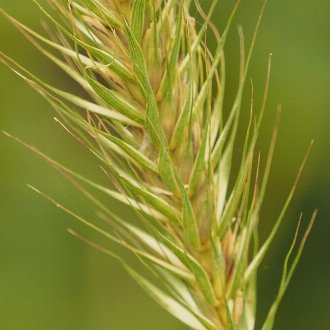Early Wildrye vs Southeastern Wildrye
These two species are similar and easily confused as both have upright spikes with long, spreading awns. They are usually easily distinguished by spike length and bloom time. E. macgregorii ranges farther north and west, and is more restricted to shadier, moister habitats with base-rich soils, whereas E. glabriflorus ranges farther southeast and onto drier, more upland habitats, and acidic soils. These species can hybridize and intergrade, so it may not be possible to ID all individuals.
Early Wildrye (Elymus macgregorii) | Southeastern Wildrye (Elymus glabriflorus) |
A perennial cool-season bunchgrass native to eastern North America, found in moist-to-mesic forests on deep, calcium-rich soils. | A perennial cool-season bunchgrass native to the southeastern to south-central US, ranging onto drier sites than most Elymus species. |
Spikes average shorter (4-12cm) and have far fewer nodes (9-16, rarely 6-20) Photo © Yann Kemper, Public Domain. | Spikes average longer (6-20cm) and have many more nodes (18-30, rarely 10-36) Photo © Haley Daniels, CC BY 4.0. |
Blooms about a month earlier, usually mid-May to mid-June, earlier in the south of its range. (Photo from Late April in Texas) Photo © Gary Rogers, CC BY 4.0. | Blooms about a month later, usually mid-June to late July, earlier in the south of its range. (Photo from Early June in Mississippi) Photo © John Kees, Public Domain. |
Longer (4-7 mm) internode distances; spike looks more sparse and it is easier to count individual nodes. Thinnest part of central stem is thinner (0.3mm) Photo © Heather DeGaetano, Public Domain. | Shorter (3-5 mm) internode distances; spike looks more densely-packed and it is harder to count individual nodes. Thinnest part of central stem is thicker (0.3-0.8mm) and is not usually visible without removing the spikelets. Photo © mefisher, Public Domain. |
Auricles, clasping outgrowths where the leaf blade meets the stem, are consistently present and larger (2-3mm) and are usually purplish black, sometimes fading to light brown. Photo © John Abrams, CC BY 4.0. | Auricles, where the leaf blades meet the stem, may be absent, and are smaller (0-2mm) when present, and average a slightly paler, more brownish color, although they may also be purplish. Photo © Kelly Bostian, CC BY 4.0. |
Found in shadier habitats, usually open bottomland forests. Restricted to moist to mesic conditions, on sites with deep, calcium-rich soils. Photo © Ken Kneidel, Public Domain. | Found in sunnier habitats, inluding in full sun and grasslands, and ventures farther into upland habitats. Tolerates much drier sites and soils lower in calcium. Photo © Kelly Bostian, CC BY 4.0. |
References & External Resources
These short lists show only links helpful for ID. For a complete list of references and resources also covering other aspects of ecology, visit the links section of the full article on each plant, which is the first entry here.












